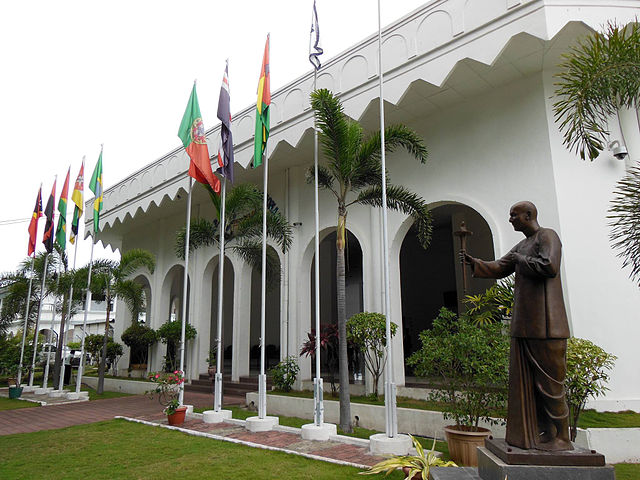Top Qs
Timeline
Chat
Perspective
Politics of Timor-Leste
From Wikipedia, the free encyclopedia
Remove ads
The political system in Timor-Leste is a unitary semi-presidential representative democratic republic,[1][2][3] whereby the Prime Minister of Timor-Leste is the head of government and the President of Timor-Leste functions as head of state. Timor-Leste has a multi-party system. Executive power is exercised by the president and the government. Legislative power is vested in both the government and the National Parliament. The Judiciary is independent of the executive and the legislature. The East Timorese constitution was modelled on that of Portugal, with lesser power given to the president.[2] The country is still in the process of building its administration and governmental institutions. The Economist Intelligence Unit rated Timor-Leste a "flawed democracy" in 2022.[4][needs update]
This article has multiple issues. Please help improve it or discuss these issues on the talk page. (Learn how and when to remove these messages)
|
Remove ads
Executive branch

The head of state of the East Timorese republic is the President, who is directly elected by popular vote for a five-year term, and whose executive powers are somewhat limited by the constitution, the president is able to veto legislation, however this action can be overridden by the parliament. Following elections, the president usually appoints the leader of the majority party or majority coalition as the prime minister,. As head of government the prime minister presides over the cabinet.
Remove ads
Legislative branch

The unicameral Timorese National Parliament (Parlamento Nacional) has 65 members elected by proportional representation (d'Hondt method) for a five-year term. The number of seats can vary from a minimum of 52 to a maximum of 65, with the exception of the first parliament, which included 88 members who previously served as the Constitutional Assembly six years rather than five (2001-2007). The longer term was in part due to the constitustion being put in place in 2002.[5]
The East Timorese constitution was modelled after that of Portugal.[6] The country is still in the process of building its administration and governmental institutions.
Remove ads
Political parties and elections
Presidential elections
Parliamentary elections
Remove ads
Recent developments
Summarize
Perspective
Francisco Guterres, known as Lú-Olo, of the Revolutionary Front for an Independent East Timor (Fretilin) was elected president in 2017 and held the position until May 2022.[9] The Alliance for Change and Progress (AMP), a three-party alliance, attempted to form a coalition with National Congress for Timorese Reconstruction, led by former president Xanana Gusmao, but the talks failed and Fretilin formed a minority government with the Timorese Democratic Party (DP) in September 2017. In October that year, the three opposition parties formed an alliance called Parliamentary Majority Oppositional Alliance (AOMP), and following pressures from this opposition alliance, president Guterres decided to dissolve the parliament in January 2018. This led to the second general election in May 2018.[10] In June 2018, former president Jose Maria de Vasconcelos known as Taur Matan Ruak of the Alliance of Change for Progress (AMP), became the new prime minister.[11] José Ramos-Horta of the centre-left CNRT has served as the president of Timor-Leste since 20 May 2022 after winning the April 2022 presidential election runoff.[12]
In parliamentary elections held on Sunday, May 21, 2023, the opposition party led by Xanana Gusmao won 41% of the vote, making him likely to return as prime minister of the country in a coalition with at least one other party.[13]
The country is aiming for admission to the Association of South-East Asian Nations (ASEAN) as a full member in 2025.[14] The Accession of Timor-Leste to ASEAN began with the country's secession from Indonesia in 2002.[15] In November of 2022, ASEAN agreed "in principle" to admit Timor-Leste with observer status.[16]
Remove ads
Judicial branch
The Supreme Court of Justice has one judge appointed by the National Parliament and the rest appointed by the Superior Council for the Judiciary. As mentioned in a 2010 source, the country was in the process of developing a legal system that includes private practice attorneys.[17]
Administrative divisions

Timor-Leste is divided into fourteen municipalities:
The districts are subdivided into 65 subdistricts, 443 sucos and 2,336 towns, villages and hamlets. "Ministerial Order" (PDF). Archived from the original on 10 January 2005. (213 KiB)
Remove ads
Cabinet
Summarize
Perspective
This article needs to be updated. (May 2022) |
- Gusmão III (2023–present)
Official Gazette of Announced Council of Ministers
- Matan Ruak (2018–2023)[18]
- Alkatiri II (2017–2018) [19]
- Araújo (2015–2017)[20]
- Gusmão II (2012-2015)[21]
- Gusmão I (2007-2012)[22]
- Alkatiri I (2002-2007)[23]
Remove ads
References
Further reading
External links
Wikiwand - on
Seamless Wikipedia browsing. On steroids.
Remove ads

